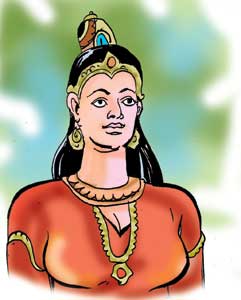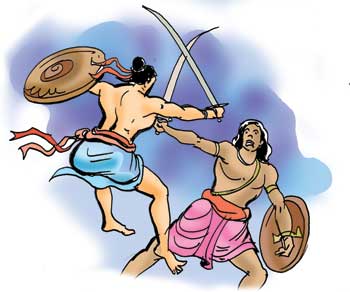
A period of unrest~This article is part of a continuing series on the ‘Mahavamsa,’ the recorded chronicle of Sri Lankan history~
Though the 'Pujavaliya' mentions this point, according to inscriptions he was the heir to the throne and the legitimate son of King Nissankamalla. After Veerabahu, it was the brother of Nissankamalla who came to the throne. He was Prince Vickramabahu. He too couldn't rule for long. His reign lasted only three months. He was killed by a prince named Chodanga, who was related to King Nissankamalla. He is described as King Nissankamalla's sister's son. He too did not live long. He could rule only for nine months. A commander named Kitti captured him, blinded him and deposed him. Then the Chief Queen of King Parakramabahu I was enthroned. This queen belonged to the Pandya clan, from the paternal side. Her grandmother had married a Pandya prince. Although in name, Queen Leelawathie ruled, the real power behind was Commander Kitti. So she became just a nominal ruler. She was crowned in the year 1119 A.D. She has maintained a 'Danasala' (where food was served) by the name 'Balau Medhavi.' She got a row of boutiques erected and the income derived from these, was given to the Danasala. One-hundred and fifty buffaloes were also donated for this. She employed 30 employees to see to the running of this Danasala. She was a very generous queen. In the pillar inscription of Puliyankulama, there is a reference to her rule. During her reign, there had been three Chola invasions. According to scholars, a book written during this period, mentions these invasions and it is said that Commander Kitti was able to chase the enemy away. On two occasions the Cholas have entered the country through the harbour at Mannar and marched up to Anuradhapura. But after fighting with the Sinhala forces, they had been defeated and had to leave. The Sinhalese were victorious. The next ruler of Polonnaruwa was Prince Sahassamalla Kalinga who happened to be a nephew of King Nissankamalla. He had been born and bred in the Kalinga country. It is on an invitation that he had come to Sri Lanka. |
|
||||||
|| Front
Page | News | Editorial | Columns | Sports | Plus | Financial
Times | International | Mirror | TV
Times | Funday
Times || |
| |
Reproduction of articles permitted when used without any alterations to contents and a link to the source page.
|
© Copyright
2008 | Wijeya
Newspapers Ltd.Colombo. Sri Lanka. All Rights Reserved. |
 After the demise of King Nissankamalla, the country was in such a turmoil, that there never was such a period of unrest. However, it is Prince Veerabahu, who was the Yuvaraja, who ascended the throne. He was the son of King Nissankamalla. He ruled for only one day. On the second day, he was assassinated. This was done by the Commander-in-Chief named Thaviru, claiming that Veerabahu was not a legitimate child of the king.
After the demise of King Nissankamalla, the country was in such a turmoil, that there never was such a period of unrest. However, it is Prince Veerabahu, who was the Yuvaraja, who ascended the throne. He was the son of King Nissankamalla. He ruled for only one day. On the second day, he was assassinated. This was done by the Commander-in-Chief named Thaviru, claiming that Veerabahu was not a legitimate child of the king. This grandmother was the sister of King Vijayabahu I. Her daughter was Queen Sugala and this queen was Queen Leelawathie's mother. As Queen Leelawathie had no connections with the Kalingas, the Kalinga dynasty, which was in power for a long period, became powerless. By this time, even the Sinhala line of kings was not heard of. As such, Queen Leelawathie could rule for a long period. She was liked by the people. Her subjects respected her.
This grandmother was the sister of King Vijayabahu I. Her daughter was Queen Sugala and this queen was Queen Leelawathie's mother. As Queen Leelawathie had no connections with the Kalingas, the Kalinga dynasty, which was in power for a long period, became powerless. By this time, even the Sinhala line of kings was not heard of. As such, Queen Leelawathie could rule for a long period. She was liked by the people. Her subjects respected her. On the third occasion, they had landed in Chilaw. This time, they had come as far as Hiripitiya in the Kurunegala district. This place is also named 'Siri Pura.' In a Chola inscription written in 1199 A.D., there is a mention to the effect that Kulothunga III, adorned his feet with the crown of the Sinhala king. This reference is not mentioned anywhere else. Neither in the inscriptions written prior to 1197 A.D. nor in the books is there a mention of even Commander Kitti.
On the third occasion, they had landed in Chilaw. This time, they had come as far as Hiripitiya in the Kurunegala district. This place is also named 'Siri Pura.' In a Chola inscription written in 1199 A.D., there is a mention to the effect that Kulothunga III, adorned his feet with the crown of the Sinhala king. This reference is not mentioned anywhere else. Neither in the inscriptions written prior to 1197 A.D. nor in the books is there a mention of even Commander Kitti.